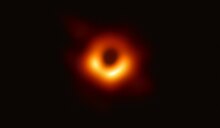Lohong hitam supermasif

−0.40 M, berbilion kali lebih besar daripada Matahari.[1] Gambar lohong hitam ini dihasilkan oleh Event Horizon Telescope pada 10 April 2019.[2][3] Gegelang ini mempunyai diameter kira-kira 700 AU, sekitar sepuluh kali lebih besar daripada orbit Neptun di sekitar Matahari. Diameternya yang jelas ialah 42 ± 3 μas.
Lohong hitam supermasif ialah jenis lohong hitam yang terbesar mengandungi jisim beratus-ratus ribu hingga berbilion kali lebih banyak daripada jisim matahari (M☉). Lubang hitam ialah kelas objek astronomi yang telah mengalami keruntuhan graviti, meninggalkan kawasan sferoid ruang yang tidak dapat dilepaskan, bahkan tidak ada cahaya. Bukti pemerhatian menunjukkan bahawa hampir semua galaksi besar mengandungi lohong hitam supermasif, terletak di pusat galaksi.[4][5] Pusat galaksi Bima Sakti mempunyai lohong hitam jenis ini yang sepadan dengan lokasi sumber radio astronomi Sagittarius A*.[6][7] Penokokan gas antara najam ke lohong hitam supermasif adalah proses yang bertanggungjawab untuk memaksa kuasar dan lain-lain jenis nukleus galaktik aktif.
Rujukan
- ^ Oldham, L. J.; Auger, M. W. (Mac 2016). "Galaxy structure from multiple tracers - II. M87 from parsec to megaparsec scales". Monthly Notices of the Royal Astronomical Society. 457 (1): 421–439. arXiv:1601.01323. Bibcode:2016MNRAS.457..421O. doi:10.1093/mnras/stv2982.
- ^ Overbye, Dennis (10 April 2019). "Black Hole Picture Revealed for the First Time - Astronomers at last have captured an image of the darkest entities in the cosmos - Comments". The New York Times. Dicapai pada 10 April 2019.
- ^ The Event Horizon Telescope Collaboration (10 April 2019). "First M87 Event Horizon Telescope Results. I. The Shadow of the Supermassive Black Hole". The Astrophysical Journal Letters. 87. Dicapai pada 10 April 2019.
- ^ Kormendy, John; Richstone, Douglas (1995), "Inward Bound—The Search For Supermassive Black Holes In Galactic Nuclei", Annual Review of Astronomy and Astrophysics, 33: 581, Bibcode:1995ARA&A..33..581K, doi:10.1146/annurev.aa.33.090195.003053
- ^ Kormendy, John; Ho, Luis (2013). "Coevolution (Or Not) of Supermassive Black Holes and Host Galaxies". Annual Review of Astronomy and Astrophysics. 51 (1): 511–653. arXiv:1304.7762. Bibcode:2013ARA&A..51..511K. doi:10.1146/annurev-astro-082708-101811.
- ^ Ghez, A.; Klein, B.; Morris, M.; Becklin, E (1998). "High Proper-Motion Stars in the Vicinity of Sagittarius A*: Evidence for a Supermassive Black Hole at the Center of Our Galaxy". The Astrophysical Journal. 509 (2): 678. arXiv:astro-ph/9807210. Bibcode:1998ApJ...509..678G. doi:10.1086/306528.
- ^ Schödel, R. (2002). "A star in a 15.2-year orbit around the supermassive black hole at the centre of the Milky Way". Nature. 419 (6908): 694–696. arXiv:astro-ph/0210426. Bibcode:2002Natur.419..694S. doi:10.1038/nature01121. PMID 12384690. Unknown parameter
|displayauthors=ignored (bantuan)
Bacaan lanjut
- Fulvio Melia (2003). The Edge of Infinity. Supermassive Black Holes in the Universe. Cambridge University Press. ISBN 978-0-521-81405-8.
- Laura Ferrarese; David Merritt (2002). "Supermassive Black Holes". Physics World. 15 (1): 41–46. arXiv:astro-ph/0206222. Bibcode:2002astro.ph..6222F. Unknown parameter
|last-author-amp=ignored (bantuan) - Fulvio Melia (2007). The Galactic Supermassive Black Hole. Princeton University Press. ISBN 978-0-691-13129-0.
- Merritt, David (2013). Dynamics and Evolution of Galactic Nuclei. Princeton University Press. ISBN 978-0-691-12101-7.
- Julian Krolik (1999). Active Galactic Nuclei. Princeton University Press. ISBN 978-0-691-01151-6.
Pautan luar
- Black Holes: Gravity's Relentless Pull Award-winning interactive multimedia Web site about the physics and astronomy of black holes from the Space Telescope Science Institute
- Images of supermassive black holes
- NASA images of supermassive black holes
- The black hole at the heart of the Milky Way
- ESO video clip of stars orbiting a galactic black hole
- Star Orbiting Massive Milky Way Centre Approaches to within 17 Light-Hours ESO, October 21, 2002
- Images, Animations, and New Results from the UCLA Galactic Center Group
- Washington Post article on Supermassive black holes
- Video (2:46) – Simulation of stars orbiting Milky Way's central massive black hole
- Video (2:13) – Simulation reveals supermassive black holes (NASA, October 2, 2018)





